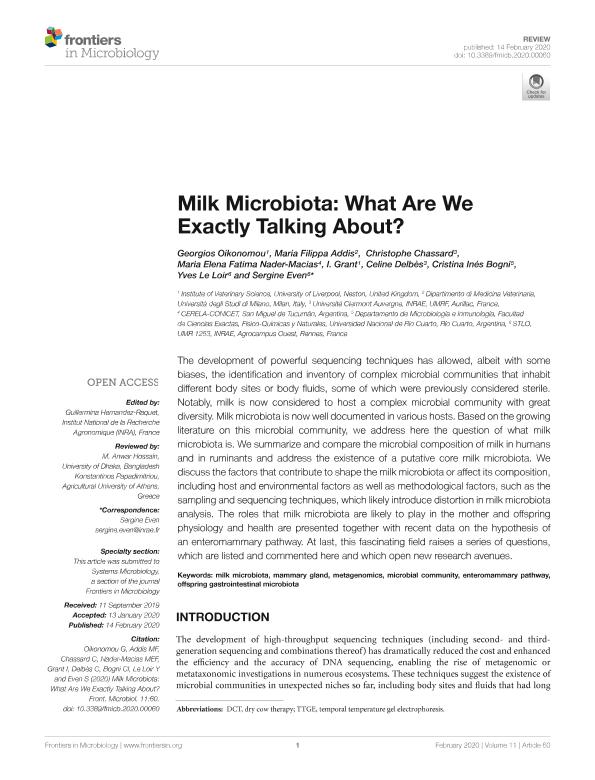Mostrar el registro sencillo del ítem
dc.contributor.author
Oikonomou, Georgios
dc.contributor.author
Addis, Maria Filippa
dc.contributor.author
Chassard, Christophe
dc.contributor.author
Nader, Maria Elena Fatima

dc.contributor.author
Grant, Irene
dc.contributor.author
Delbès, Celine
dc.contributor.author
Bogni, Cristina Ines

dc.contributor.author
Le Loir, Yves
dc.contributor.author
Even, Sergine
dc.date.available
2021-08-12T18:40:32Z
dc.date.issued
2020-02-14
dc.identifier.citation
Oikonomou, Georgios; Addis, Maria Filippa; Chassard, Christophe; Nader, Maria Elena Fatima; Grant, Irene; et al.; Milk microbiota: what are we exactly talking about?; Frontiers Research Foundation; Frontiers in Microbiology; 11; 60; 14-2-2020; 1-15
dc.identifier.issn
1664-302X
dc.identifier.uri
http://hdl.handle.net/11336/138226
dc.description.abstract
The development of powerful sequencing techniques has allowed, albeit with some biases, the identification and inventory of complex microbial communities that inhabit different body sites or body fluids, some of which were previously considered sterile. Notably, milk is now considered to host a complex microbial community with great diversity. Milk microbiota is now well documented in various hosts. Based on the growing literature on this microbial community, we address here the question of what milk microbiota is. We summarize and compare the microbial composition of milk in humans and in ruminants and address the existence of a putative core milk microbiota. We discuss the factors that contribute to shape the milk microbiota or affect its composition, including host and environmental factors as well as methodological factors, such as the sampling and sequencing techniques, which likely introduce distortion in milk microbiota analysis. The roles that milk microbiota are likely to play in the mother and offspring physiology and health are presented together with recent data on the hypothesis of an enteromammary pathway. At last, this fascinating field raises a series of questions, which are listed and commented here and which open new research avenues.
dc.format
application/pdf
dc.language.iso
eng
dc.publisher
Frontiers Research Foundation

dc.rights
info:eu-repo/semantics/openAccess
dc.rights.uri
https://creativecommons.org/licenses/by-nc-sa/2.5/ar/
dc.subject
ENTEROMAMMARY PATHWAY
dc.subject
MAMMARY GLAND
dc.subject
METAGENOMICS
dc.subject
MICROBIAL COMMUNITY
dc.subject
MILK MICROBIOTA
dc.subject
OFFSPRING GASTROINTESTINAL MICROBIOTA
dc.subject.classification
Otras Ciencias Veterinarias

dc.subject.classification
Ciencias Veterinarias

dc.subject.classification
CIENCIAS AGRÍCOLAS

dc.title
Milk microbiota: what are we exactly talking about?
dc.type
info:eu-repo/semantics/article
dc.type
info:ar-repo/semantics/artículo
dc.type
info:eu-repo/semantics/publishedVersion
dc.date.updated
2021-07-30T18:49:50Z
dc.identifier.eissn
1664-302X
dc.journal.volume
11
dc.journal.number
60
dc.journal.pagination
1-15
dc.journal.pais
Suiza

dc.journal.ciudad
Lausana
dc.description.fil
Fil: Oikonomou, Georgios. University of Liverpool; Reino Unido
dc.description.fil
Fil: Addis, Maria Filippa. Università degli Studi di Milano; Italia
dc.description.fil
Fil: Chassard, Christophe. Institut National de la Recherche Agronomique; Francia
dc.description.fil
Fil: Nader, Maria Elena Fatima. Consejo Nacional de Investigaciones Científicas y Técnicas. Centro Científico Tecnológico Conicet - Tucumán. Centro de Referencia para Lactobacilos; Argentina
dc.description.fil
Fil: Grant, Irene. University of Liverpool; Reino Unido
dc.description.fil
Fil: Delbès, Celine. Institut National de la Recherche Agronomique; Francia
dc.description.fil
Fil: Bogni, Cristina Ines. Universidad Nacional de Río Cuarto; Argentina
dc.description.fil
Fil: Le Loir, Yves. Institut National de la Recherche Agronomique; Francia
dc.description.fil
Fil: Even, Sergine. Institut National de la Recherche Agronomique; Francia
dc.journal.title
Frontiers in Microbiology
dc.relation.alternativeid
info:eu-repo/semantics/altIdentifier/doi/http://dx.doi.org/10.3389/fmicb.2020.00060
dc.relation.alternativeid
info:eu-repo/semantics/altIdentifier/url/https://www.frontiersin.org/articles/10.3389/fmicb.2020.00060
Archivos asociados
